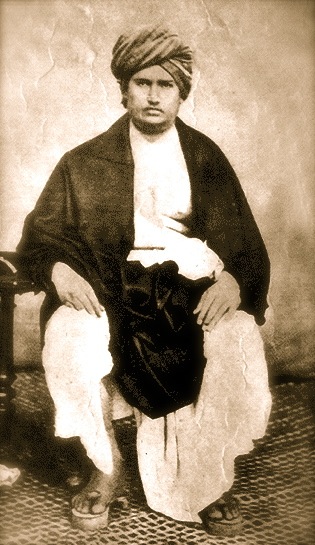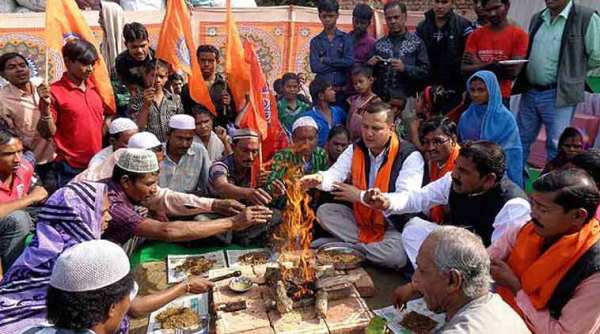The Shuddhi Movement led by Swami Dayananda Saraswati was one of the crucial events in the Indian Struggle for Freedom. The early 20th century was a phase of several religious and cultural movements in India. Both Hindus and Muslims were becoming ever more assertive in cultural and political spheres. The consolidation of British imperialism was accompanied by an expansion of Christianity in India. The expansion of Christianity was seen as a threat to Hindu religious identity. It was felt so more because of the increasing conversion of Hindus to Christianity.
The Arya Samaj movement that opposed certain ideological premises of liberal Hindu reformers like Raja Ram Mohan Roy laid the foundation for revivalism and reclaiming of Hinduism in India. The practice of Suddhikaran – a process of re-conversion to Hinduism, was started by the founder of the Arya Samaj movement. Swami Dayanand Saraswati led the movement of re-converting Indians to Hinduism. Later, the process of reconversion evolved to become the Sudhi movement. The Sudhi movement was not merely a movement of Hindu proselytization. It had a larger critique of colonialism and its religious and cultural hegemony.
The protagonists of the movement were keen to call it a purifying and homecoming process. The follower of Arya Samaj like the Swami Shraddhanand consolidated the movement by forming a Sangathan. Shraddhanand’s works started in North India and gradually spread all over India. The Sudhi movement succeeded in the successful reconversion of Muslims and Christians back to Hinduism.
The main rationale of the Shuddhi Movement
The Shuddhi movement was founded on the philosophy and legacy of Arya Samaj. The Arya Samaj as a social transformation movement was founded in the year 1875. It was founded by Dayanand Saraswati. He took a leading role in translating Vedic learning materials into Hindi. It came about as a response to reformists who were largely swept away by the European enlightenment values. It was a social reform movement with an Indian premise.
Arya Samaj regarded Vedas as the origin and source of all wisdom and virtues. According to them, it had elements that the world could replicate. The Sudhi movement was a specific attempt to bring back those who had been already converted to Islam and Christianity. The process of reconverting Hindus was accompanied by a Sanghathan movement which was launched to unify the Hindus. Literally speaking Shuddhi means purification but when used by the Arya Samajists it stood for reconversion. The Samaj being a Vedic church received considerable success in reconverting Hinduism.
The main rationale of the Shuddhi movement, according to Dayanand Saraswati, was to reject all non-Vedic beliefs. The Shuddhi movement, however, did not fail to reject idolatry, animal sacrifices, ancestor worship, pilgrimages, priestcraft, casteism, untouchability, and child marriages. The Arya Samajist thought that such practices were not permitted in the Vedic tradition. A crucial aspect of the Shuddhi movement was to establish a system of Vedic churches to secure Hindu traditional values.

Though it agreed with several liberal reform agendas, the Shuddhi movement had a revivalist orientation. It also involved itself in the abolition of untouchability. One of the main objectives was to expand the horizon of Hinduism as it attempted to bring outcastes back to the Hindu religious fold. While opposing untouchability it gained empathy from the outcaste. The opposition to untouchability was accompanied by a continuous process of converting outcasts from other religions to Hinduism. The Shuddhi movement gained wider popularity as it defended the integration of outcastes into mainstream Hinduism.
To make the depressed class self-reliant, the Shuddhi movement thought it essential to elevate the position of outcasts in the social hierarchy. One of the main concerns was to control the growing conversion to Islam and Christianity. It saw colonialism and foreign rule as a threat to the Hindu way of life.
Contributions of Shuddhi Movement
The Shuddhi movement continuously expressed the need to recover Hindu nationalism in India which otherwise they thought had the risk of endangering India’s Hindu identity. The Shuddhi movement was adamant in upholding the infallibility of the Vedas which was integral to India’s social and national progress. The main contribution of the movement was to pursue a process of Hindu purification.
The idea of reformation propagated by Arya Samaj was predominantly appreciated. In the field of education, Swami Dayananda who founded the Gurukul education system was respected by the Hindus and Muslims. The Gurukul system of education did not discriminate against anyone on the grounds of gender, caste, and creed. It encouraged gender parity as both were advised to inculcate the urge for knowledge. The Gurukul system as an alternative to the Western educational system
The followers of Arya Samaj took a hardened position on inter-community relations. For example, the legacy of the Sudhi movement was appropriated by the conservative Hindu revivalists and nationalists. Swami Shradhanand who was arrested and jailed for his participation in the Khilafat movement after his release from the jail claimed that Hindus were being coercively converted to Islam. With an aim to reconvert them, Shradhanand started the Shudhi movement. A distinct legacy of the movement was the formation of Bhartiya Hindu Shuddhi Mahasabha in 1923. The biggest point of difference between the Shuddhi movement and Muslims emerged on the issue of reconversion of Malkana Rajputs in the United Province.
In 1926, Swami Shraddhanand died and the Shuddhi movement lost its rigor. Because of his saintly character and consistent campaigns, more than 18,000 Muslims returned to the Hindu fold in some parts of the United Province. The movement succeeded in reconverting a good number of Hindus who were allegedly converted to other faiths – Islam and Christianity. The Sudhikaran movement spread to the South Indian region as well. The Sudhikaran movement tried to reconvert those who were considered to have been forcefully converted to Islam during the Mopla rebellion in 1920 in Kerela.
The allegations of the Shuddhi movement were not received in a good light by the Muslims in India. By the middle of the 1920s, the communal and caste divisions in India had become open. The time of its formation coincided with the growing radicalization of Hindu cultural nationalism in India. The Rashtriya Swayam Sevak Sangh (RSS) was formed in September 1925. The rise of Gandhi in the national scene did try to pacify the Muslims and minorities. However, did not deter Muslims and minorities from becoming more aggressive.
The rise of Hindu revivalist forces was seen as a challenge to the 1200-year-old presence of the Islamic identity. The Hindu-Muslim contestation led to the murder of Lala Ram Chandra in Kashmir in 1923. Subsequently, Swami Shraddhananada was murdered in 1926.
The impact of the Shuddhi Movement
The revivalist orientation and assertion for the reconversion of Muslims and Christians agonized over the inter-community relations in India. The Christians and Muslims in India were becoming equally assertive. The ethnic polarization led to the militant mobilization of community politics in India. When the Indian National Congress resolved to demand the Poorna Swaraj – complete independence – of India in 1929, the Muslims and depressed classes in India were persistent in their alternative political arrangement. The Muslims began to demand the two-nation theory while the depressed classes began to demand a separate electorate system.
Another impact was the adoption of an aggressive policy of conversion to Islam by the Muslim clerics. The Muslims in India began to denounce the thesis of Swami Dayananda who viewed that it was the duty of Hindus to expiate for their past sins and non-Hindus must have nothing to do with it. Responding to the Sudhi movement, Yakub Hassan – a Muslim leader openly called upon the Muslims to convert all the untouchables in India to Islam. Several Muslim and Christian Congressmen did not appreciate such a polarising cultural perspective.
Some of the liberal nationalists in India questioned the critics of Swami and the movements that followed him. India’s first President Dr. Rajendra Prasad did not see any crisis when the Hindus were in search of their roots and promotion of cultural and religious values. Dr. Rajendra was of the view that all regions, including Islam and Christianity, were doing the same. According to him, ‘the Hindus must have the same rights of propagating as others have.’

According to Arya Samajists, there was a fundamental difference between Christianity and Hinduism. Unlike Islam and Christianity, they did not consider the text of Veda as a claimant of exclusive and supreme divinity. They viewed that Hinduism was a victim of such a cosmopolitan perspective. Dayanand Saraswati was of the view it caused hardships to the growth of Hinduism. He was of the view that there was a need to learn and replicate from the evangelical system of Christianity and Islam.
According to Saraswati, to recover the lost glory of Hinduism there was a need to adopt a militant reclaiming of Hindu cultural ethos. As time progressed, the Arya Samajists began to stress lifting Hindu Vedas – ancient scriptures – to the level of supernatural authority as accorded to Christian and Islamic religious decrees. The revivalist position taken by the Arya Samajists helped in shaping the views of the Sudhi movement in India. The ideas and works of the Shuddhi movement were appropriated by the right-wing nationalist forces in India.
Following the footprints of Arya Samaj, the Shuddhi movement worked with an objective to recover and revive the forgotten values of the Aryan culture. It asked Indians to inspire themselves and take pride in their indigenous heritage. Sudhi movement was an aggressive method of the later reformers who thought it necessary to revive Hindu cultural values to question foreign rule in India. The revivalist aspirations of the Arya Samaj and Shuddhi movement were, however, often in contradiction with the modern democratic and secular ethos that was germinating in the nationalist imagination of India. It remained a bone of contention during the anti-colonial struggle of India.

